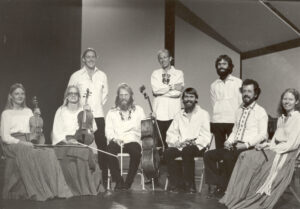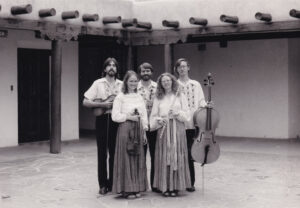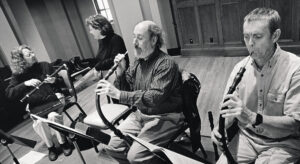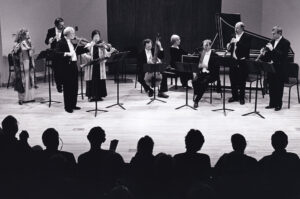History
By Bernard van der Hoeven with assistance from Carol Redman


Imagine 1977, a young New Mexico couple, eminent woodwind musicians Tom O’Connor and Carol Redman, joining string and keyboard friends, initially 9 in all, embarking on a musical journey through the wilds of New Mexico, playing classical music for everyone. Real troubadours of music for the people. That’s how it all started – what has now become the Santa Fe Pro Musica we all love.
Their initial funding came from CETA grants (Comprehensive Employment and Training Act). For this they needed the blessing of the then Governor Jerry Apodaca, who enthusiastically approved three $50,000 grants, each of 6 month’s duration. From 1978 to 1980 our roving band performed over 100 free concerts, all over New Mexico, in small towns, pueblos, schools, churches, parks, markets, senior centers, hospitals, libraries, scientific labs, even the state penitentiary.
Once the CETA grants ran out, our troubadours morphed into the Ensemble of Santa Fe (ESF) which was formally established on June 6, 1980. With the successful CETA track record, NEA and NM Arts grants followed. Performance venues now centered in Santa Fe and included St. Francis Auditorium, the Great Hall at St. John’s College, Loretto Chapel, Santuario de Guadalupe, and the Lutheran Church in Los Alamos. The 1991-92 season included 20 concerts, with 5 to 7 artists per concert. In addition to performing in all these concerts, Tom and Carol did all the administrative work – creating concert programs, hiring musicians, purchasing music, scheduling rehearsals, securing venues, ordering tickets, doing stage management, paying bills, and creating and distributing publicity. Consider for a minute that there was no internet in those days. Tom and Carol would get into Tom’s 1963 Volvo and head out across the landscape between Santa Fe and Los Alamos. With Tom driving, Carol affixed flyers to all approved surfaces at libraries, markets, senior centers, telephone poles, etc. Their concerts were usually sold out.


In 1994, the ESF was given the opportunity to establish an orchestra concert series, in addition to their ongoing chamber music series, a situation that triggered the change in name. Hiking through the Arroyo Frijoles, Tom and Carol came up with the name “Santa Fe Pro Musica.” They wanted a name that would be flexible and open-ended, not restricted to any particular classical music format. Chamber music or orchestra? Why not both! Tom’s comments celebrating the legacy of ESF: “The Ensemble of Santa Fe performed 14 years of chamber music concerts with artists from across the southwest and guests of international acclaim, and commissioned 11 new works under its Music in America project.”
In his opening comments for the 1994-95 season, Tom wrote: “It is with anticipation and excitement that we welcome you to SANTA FE PRO MUSICA! We have scheduled 27 performances of 12 repertoires encompassing chamber music and orchestral works of the greatest baroque and classical composers and a spicy mix from the 20thcentury.” Performance venues during the 1990s were primarily Loretto Chapel and the James A. Little Theater.

In 1996, Tom and Carol acted on their interest in baroque instruments and attended a 2-week summer program at the Oberlin College Baroque Performance Institute. As a result, they met several giants of the baroque musical world. These experts were hired to play concerts with Santa Fe Pro Musica, and Tom, Carol and other orchestra members played as seconds to the experts. What a perfect way to learn the craft!
Also, during this period SFPM became a Smithsonian Affiliate (1999-2004), and thus a stream of fabulous opportunities came their way. Because of this connection, in 2001 SFPM hosted the Decorated Strads from the Smithsonian collection, and the following year the quartet of Amati string instruments. As well as spectacular chamber music performances, these instruments were on display at the Gerald Peters Gallery. And the insurance, logistical and security issues involved in bringing these instruments to NM? Think separate airline flights, armed guards, and State Police escorts.
Another high-water mark of the Smithsonian relationship was the enormously successful concert tour in 2000, on the 250th anniversary of Bach’s death, of Bach’s St. Matthew Passion. It comprised two baroque instrument orchestras, plus vocal soloists and choir, and was performed at William and Mary College (Williamsburg VA), in Washington DC, at Oberlin College, in Albuquerque, and concluded at the Santa Maria de la Paz Catholic Church in Santa Fe. Their exploration of the large-scale works of Bach also included baroque instrument performances of his Christmas Oratorio, St. John Passion, and B Minor Mass. The grand finale of the Smithsonian Affiliation was the creation of two stunning CDs – the small ensemble versions of Mahler’s Fourth Symphony and Mahler’s Das Lied von der Erde (which received a 2008 Grammy Nomination for Best Classical Album/Small Ensemble).
Of particular note during this decade was the SFPM benefit event featuring Yo Yo Ma / Colin Jacobsen / Joel Fan at the Santa Fe Opera in the summer of 2003. It was so successful that the concert was held up for 45 minutes as state police were called in to untangle the serious traffic congestion from Highway 285 onto Opera Drive.
The next major transition for SFPM was Tom’s decision to step away from playing oboe and become a conductor. Catalyst to this new role occurred in 2005 when Tom initiated a joint production with SFPM and the National Dance Institute (NDI) of a choreographed version of Prokofiev’s Peter and the Wolf. Since he personally identified so strongly with this project, he decided to conduct it himself. Thus he partook of the forbidden fruit and it was delicious. And we all see how that has evolved over the past 11 years. He took a lot of heat in the press at the time but we are the fortunate recipients of his growth and dedication (and stubbornness!). During rehearsals, it is abundantly evident the mutual respect Tom and the musicians have for each other, for Tom’s depth of knowledge, his ideas and his leadership. Particularly in the last 5 years it is amazing to see how the orchestra under Tom’s leadership has gelled into world class quality. Just ask the musicians!
